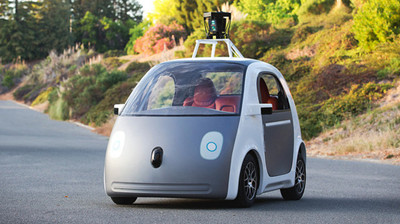無人駕駛汽車
In the self-driving seat
坐在無人駕駛汽車的座位上
Google is miles ahead of its rivals in the race for autonomous motoring
谷歌在無人駕駛領域研發的競爭中已甩開對手幾條街
Not quite as glamorous as “Knight Rider”
不如“霹靂游俠”有魅力

TO GOOGLE is now in broad usage as a verb for retrieving information from the internet. If the tech giant has its way, “I Googled” will become a standard reply to the question, “How did you get here?” On May 28th Google said it would build 100 prototype driverless cars devoid of pedals, steering wheel or controls save an on/off switch. It is the next stage in its apparent quest to be as ubiquitous on the road as on computer screens.
如今,“谷歌”常被廣泛用于互聯網信息檢索,因而“谷歌”常被用作動詞。如果這一科技巨頭獨行其道,對于“你是怎么過來的?”這種問題,它的標準答案將會是“我谷歌來的”。5月28日,谷歌表示,其將制造100輛無人駕駛原型車,它們沒有踏板,沒有方向盤,也沒有其他各類控制表盤,只留下一個開關鍵。谷歌希望在無人車的市場能夠做到與搜索市場一樣,給人們提供生活中必不可少的服務,這顯然是下一階段追求。
People have dreamed about driverless motoring since at least the 1930s, but only in recent years have carmakers such as Mercedes-Benz and Volvo given the matter more thought, kitting out test cars with the sensors and sophisticated software required to negotiate busy roads. Google has roared ahead by designing a driverless car from the ground up.
至少從19世紀30年代起,人們就已經開始設想無人駕駛汽車,但只有一些汽車制造商,如奔馳、沃爾沃,在近些年嘗試把這一想法付諸實踐。一輛裝備著傳感器和復雜軟件的測試車需要在繁忙的道路上權衡最佳行車方案。谷歌公司從零起步,設計無人駕駛汽車,已經鶴立雞群。
But bringing autonomous motoring to the world is proving harder than Google had envisaged. It once promised it by 2017. Now it does not see production models coming out before 2020. The technology is far advanced, but needs shrinking in size and cost—Google's current test cars, retrofittedToyotaand Lexus models, are said to be packed with $80,000-worth of equipment.
但是現實證明,無人駕駛汽車的面世比谷歌預想的要難。它曾承諾到2017年就能面世。而今預計產品模型不會在2020年前被制造出來。這項技術十分超前,但需要縮減產品尺寸及成本,谷歌現階段的測試車改裝自豐田和雷克薩斯的車型,據說測試車里塞滿了價值8萬美元的設備。
Google's latest efforts may have as much to do with convincing the public and lawmakers as refining the technology. The firm stresses the safety advantages of computers being more likely than humans to avoid accidents. The cars will have a top speed of just 25mph and a front end made of soft foam to cushion unwary pedestrians. The benefits could indeed be huge. Driving time could be given over to working, snoozing or browsing the web. Rather than suffer all the costs of owning a car, some people may prefer to summon a rented one on their smartphones whenever they need it. However, the issue of liability in the event of a driverless car crashing has yet to be resolved.
谷歌最近不僅要努力的完善這項技術,還要同樣努力的說服公眾及立法者。谷歌強調此產品的優勢是安全性,在避免車禍方面,電腦比人類表現更佳。無人駕駛汽車最高車速僅為25英里每小時,其前端由軟泡沫材料制造而成,可緩沖粗心的行人。這樣確有很大好處。開車的時間可以用于工作,打盹或上網沖浪。比起自己承擔擁有一輛車的開銷,一些人可能更喜歡在需要車的時候,用他們的智能手機叫輛出租車。然而,無人駕駛汽車發生車禍時的責任認定問題還有待解決。
Turning cars into commodities may not be good news for traditional carmakers. But reinventing motoring as a service fits neatly with Google's plans to become as big in hardware as in software. And unlike car firms, which talk vaguely of becoming “mobility providers”, Google has pots of cash to make that a reality and no worries about disrupting its current business. Google admits it still has “lots of work to do”. But one day Googling to the shops may be a common activity.
對傳統汽車制造商來說,把無人駕駛汽車轉化成為商品,也許不是什么好消息。但是把汽車徹底轉變成一種服務,正好契合了谷歌想在硬件領域發展的和在軟件領域一樣強大的計劃。普通汽車公司模糊的表達著成為“移動供應商”的想法,和這些汽車公司不同,谷歌擁有大量資金來實現無人駕駛的設想,并不擔心這一項目會擾亂目前公司業務。谷歌承認這一項目還有很多工作要做。但是,有一天,乘坐谷歌無人駕駛汽車去商店購物,也許會變成尋常事。












